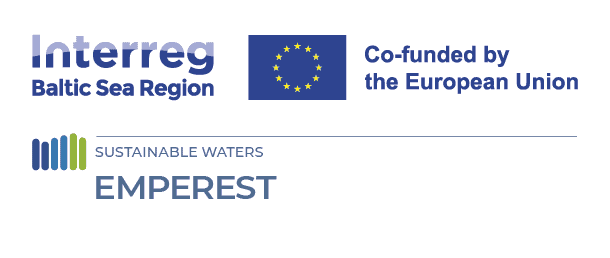
UBC TALKS webinar with solutions for PFAS in cities
03 April 2024
What can cities do?
The webinar was opened with an introduction to PFAS delivered by the researcher Piia Leskinen from Turku University of Applied Sciences, EMPEREST project partner. PFAS, a group of man-made fluorinated substances, are used in a wide variety of products such as firefighting foams, non-stick frying pans, food packaging, cosmetics, textiles for furniture and outdoor clothing, paints and photography, pesticides and pharmaceuticals. PFAS are popular in these products especially because of their water and grease resisting qualities. However, these qualities also make them extremely persistent in the environment.
When PFAS substances end up in water, soil, plants, animals or humans, they most likely stay. Piia explained that studies indicate PFAS are potentially hazardous for human health in terms of the cardiovascular system or the development of fetuses and children, for instance. Awareness of the PFAS risks has grown in recent years in many countries due to revelations and media coverage showing high concentrations of PFAS in drinking water, fish, eggs or human blood.
Growing concern has been translated into both developing regulation and research on alternatives in product manufacturing. Different standards and directives at the EU level have been created especially to protect drinking water and food. New regulation is currently being prepared in the EU, including a PFAS restriction. In the private sector, forerunner companies are looking for safer chemicals for substitution.
Cities play a key role in the work against PFAS pollution. It is actually the cities, local authorities and water utilities who will take most regulation into action. Cities can also protect the environment and people through hotspot mapping, risk management and remediation. Furthermore, cities can pay attention to the procurements they make and only accept PFAS free products.
“We have to start asking for PFAS free products. Consumers have a lot of power in this, and municipalities are especially powerful customers with all the public procurements they make.”
— Dr Piia Leskinen, Principal Lecturer and researcher at Turku University of Applied Sciences
Piia Leskinen also invited cities to continue participating in events organized by projects like EMPEREST. They are often free of charge, and they are an excellent way to get informed and increase the level of expertise in the municipality.
In the second presentation of the webinar, UBC SCC Project Coordinator Lotta Lehti presented the focus of EMPEREST, the project umbrella for this webinar. The project focuses on PFAS pollution in particular at one point of the water management cycle: wastewater treatment. However, in order to eliminate PFAS from wastewater, removal technologies are not enough but also monitoring PFAS concentrations in the aquatic environment and mitigating PFAS risks in cities are needed. Further, training and awareness raising are crucial in the work against PFAS pollution. EMPEREST adopts a holistic approach and therefore works on all these aspects mentioned.
Mapping and monitoring PFAS in the Baltic Sea Region
Dr Kamila Gruškeviča from Riga Technical University presented the risk assessment approach being developed in EMPEREST. The project will prepare a tool for cities and water utilities to facilitate their work in the identification, assessment and mitigation of PFAS risks in the environment and the water management cycle.
The interactive tool will allow detecting city-specific PFAS risks. With 8-10 simple questions users will be able to map PFAS-related industries located in the city as well as sites such as airports and rescue services. The tool can be further used with a more elaborated approach guiding the investigation into PFAS pollution sites, taking water samples to detect PFAS concentrations and, finally, preparing a plan for PFAS risk mitigation in the city.
Another approach to PFAS monitoring in EMPEREST was presented by Markus Raudkivi from HELCOM, which is leading the project’s regional monitoring and assessment work as the principal environmental Baltic Sea organisation. The objective is to fill in gaps in knowledge concerning PFAS concentrations in the Baltic Sea and its catchment area and to create methodological recommendations for monitoring and assessment of PFAS in the aquatic environment.
“Monitoring is key in understanding the current status of the pollution and in potentially taking steps to mitigate it.”
— Markus Raudkivi, Project Coordinator at HELCOM
As a part of the EMPEREST activities, a data call was issued last year to the Baltic Sea countries to collect PFAS environmental monitoring data on water, biota and sediment. The call resulted in a database of around 186 000 PFAS measurements points. Preliminary results of the analyses suggest there is a big PFAS problem in the region since about 25 years: based on the sediment samples, it doesn’t have old roots, while the biota samples indicate that this problem is growing right now. All the data analyses will be used as a basis for the monitoring and assessment plan created in the EMPEREST project – and the draft of the monitoring and assessment plan will be published soon.
The closing words of the webinar were given by Louise Floman (Swedish Agency for Marine and Water Management), the Coordinator of the Policy Area ‘Hazards’ of the EU Strategy for the Baltic Sea Region. Louise emphasized that the work done in EMPEREST is an important contribution to the objective “Save the Sea” and pollution-related actions in the EUSBSR Action Plan. Connecting the work of EMPEREST to the EUSBSR level – for example via the Baltic Sea PFAS network – will help to develop a common understanding, to work on capacity building, and to share practices and methodologies related to the reduction of PFAS pollution.





